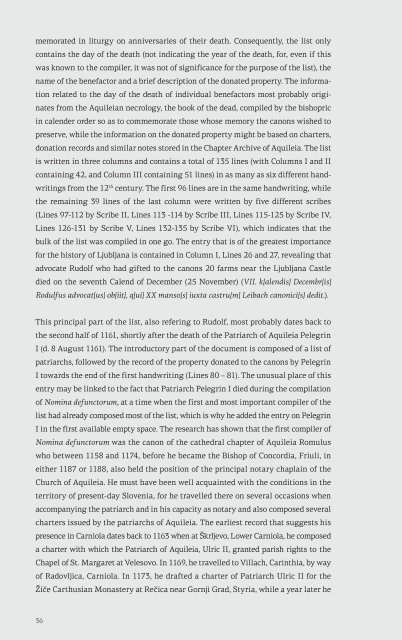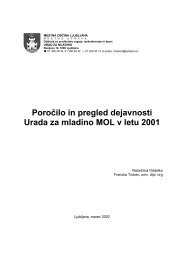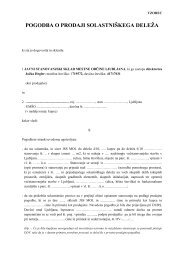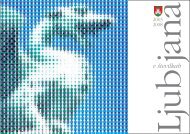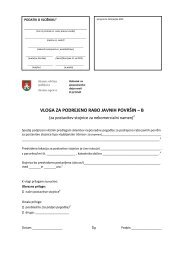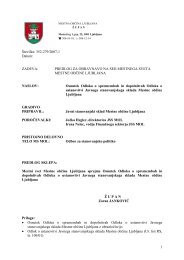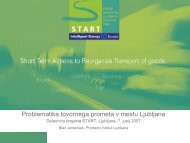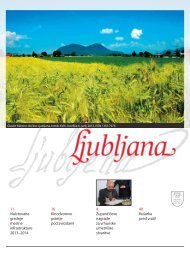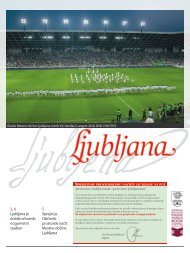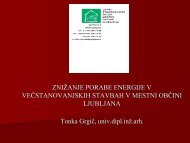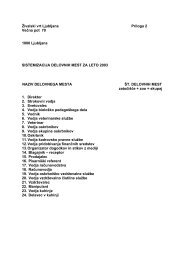You also want an ePaper? Increase the reach of your titles
YUMPU automatically turns print PDFs into web optimized ePapers that Google loves.
memorated in liturgy on anniversaries of their death. Consequently, the list onlycontains the day of the death (not indicating the year of the death, for, even if thiswas known to the compiler, it was not of significance for the purpose of the list), thename of the benefactor and a brief description of the donated property. The informationrelated to the day of the death of individual benefactors most probably originatesfrom the Aquileian necrology, the book of the dead, compiled by the bishopricin calender order so as to commemorate those whose memory the canons wished topreserve, while the information on the donated property might be based on charters,donation records and similar notes stored in the Chapter Archive of Aquileia. The listis written in three columns and contains a total of 135 lines (with Columns I and IIcontaining 42, and Column III containing 51 lines) in as many as six different handwritingsfrom the 12 th century. The first 96 lines are in the same handwriting, whilethe remaining 39 lines of the last column were written by five different scribes(Lines 97-112 by Scribe II, Lines 113 -114 by Scribe III, Lines 115-125 by Scribe IV,Lines 126-131 by Scribe V, Lines 132-135 by Scribe VI), which indicates that thebulk of the list was compiled in one go. The entry that is of the greatest importancefor the history of <strong>Ljubljana</strong> is contained in Column I, Lines 26 and 27, revealing thatadvocate Rudolf who had gifted to the canons 20 farms near the <strong>Ljubljana</strong> Castledied on the seventh Calend of December (25 November) (VII. k[alendis] Decembr[is]Rodulfus advocat[us] ob[iit], q[ui] XX manso[s] iuxta castru[m] <strong>Leibach</strong> canonici[s] dedit.).This principal part of the list, also refering to Rudolf, most probably dates back tothe second half of 1161, shortly after the death of the Patriarch of Aquileia PelegrinI (d. 8 August 1161). The introductory part of the document is composed of a list ofpatriarchs, followed by the record of the property donated to the canons by PelegrinI towards the end of the first handwriting (Lines 80 – 81). The unusual place of thisentry may be linked to the fact that Patriarch Pelegrin I died during the compilationof Nomina defunctorum, at a time when the first and most important compiler of thelist had already composed most of the list, which is why he added the entry on PelegrinI in the first available empty space. The research has shown that the first compiler ofNomina defunctorum was the canon of the cathedral chapter of Aquileia Romuluswho between 1158 and 1174, before he became the Bishop of Concordia, Friuli, ineither 1187 or 1188, also held the position of the principal notary chaplain of theChurch of Aquileia. He must have been well acquainted with the conditions in theterritory of present-day Slovenia, for he travelled there on several occasions whenaccompanying the patriarch and in his capacity as notary and also composed severalcharters issued by the patriarchs of Aquileia. The earliest record that suggests hispresence in Carniola dates back to 1163 when at Škrljevo, Lower Carniola, he composeda charter with which the Patriarch of Aquileia, Ulric II, granted parish rights to theChapel of St. Margaret at Velesovo. In 1169, he travelled to Villach, Carinthia, by wayof Radovljica, Carniola. In 1173, he drafted a charter of Patriarch Ulric II for theŽiče Carthusian Monastery at Rečica near Gornji Grad, Styria, while a year later hewrote a charter of the same patriarch who had arbitrated a dispute over the Churchof St. Pancras in Slovenj Gradec between the Abbot of Beligna and the Archdeaconof the Savinja region. Romulus visited the Slovene territory for the last time in1177 when he wrote a charter for the Stična Cistercian Monastery in Carniola.The above-mentioned entry refers to Rudolf as advocatus, which means that he wasan advocate of the Church of Aquileia, representing the interests of the church insecular matters, either as a judge (in relation to the bishop's vassals) or a counsel in aproceeding. It may therefore be inferred that advocateship was associated with powerand income and that only members of the highest nobility could become advocates ofsuch dignitaries as the Patriarchs of Aquileia. In 1125, this office, previously held bymembers of various families of high nobility, became hereditary to the family of theCounts of Gorizia. In the second half of the 11 th century, this office was held by theEppensteins, a Carinthian ducal family, with Marquard (1064 – 1074) and his sonHenry III as advocates. Allegedly, Henry III stopped being the advocate of the Churchof Aquileia in the years between 1090 and 1093 when he was appointed the Duke ofCarinthia. He was succeeded in the function of advocate by Burkhard of Moosburg,Bavaria, the Margrave of Istria, who was later succeeded by his son-in-law Conrad ofLungau in 1102 at the latest. Conrad continued being the advocate of the Church ofAquileia until his death in 1112. With the exception of Burkhard, all the above-listedadvocates are mentioned in Nomina defunctorum as benefactors of the Chapter ofAquileia. Marquard appears in Column I, Line 29, Henry in Column I, Lines 22-24,and Conrad in Column I, Line 25. In view of the fact that there is no evidence of anotherholder of this function between Conrad and Meinhard I of Gorizia who is reportedto have been the advocate of the Church of Aquileia in 1125, and that the entryon Conrad in Nomina defunctorum is followed by the entry on Rudolf and his donation(Column I, Lines 26-27), we may justly conclude that Rudolf must have been the advocateof the Church of Aquileia during this interim period (1112 – 1125) and that thedonation of twenty farms near the <strong>Ljubljana</strong> Castle dates to this very period.Such a conclusion, based on the reference to Rudolf in Nomina defunctorum, is alsocorroborated by a charter dated 7 April 1126 and issued somewhere along the Isonzo/Soča River in Friuli (actum Ysonzo). It is reported that a certain Rudolf from “the placeof Tarcento” (Růdolfus de loco Tercento) bestowed upon the Provostship of St. Peter inBerchtesgaden, west of Salzburg, a rich property he owned in Carnia and Friuli. Theevent on the Isonzo/Soča was attended by a circle of most prominent members ofhigh nobility whose presence shows that Rudolf of Tarcento, a place located north ofUdine, Friuli, must have belonged to the same social class. The first on the list of dignitariesattending the event in 1126 was Count Bernhard of Spanheim (d. 1147), whowas a leading member of the Spanheim family at that time and in whose charter from1146 the afore-mentioned Spanheim ministerial Ulric of <strong>Ljubljana</strong> is referred to.Bernhard was escorted by his older brother Engelbert II (d. 1141), the Duke of Carin-3637


